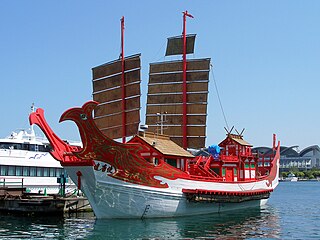Related Research Articles

Fujiwara no Yoshifusa, also known as Somedono no Daijin or Shirakawa-dono, was a Japanese statesman, courtier and politician during the Heian period.
Nihon Kingendaishi Jiten is a dictionary of contemporary Japanese history published in 1978, as the revision of Nihon Kindaishi Jiten of 1958. Both editions were published by Tôyô Keizai Shinpôsha (東洋経済新報社) and were edited by a committee organized by the Faculty of Letters at Kyoto University. The new edition: Nihon Kingendaishi Jiten has an extensive coverage of Japanese history from 1848 to 1975, with a particular focus on contemporary Japanese history.

Japanese words of Dutch origin started to develop when the Dutch East India Company initiated trading in Japan from the factory of Hirado in 1609. In 1640, the Dutch were transferred to Dejima, and from then on until 1854 remained the only Westerners allowed access to Japan, during Japan's sakoku seclusion period.
Kiyoshi Nishiyama was a versatile Japanese amateur photographer who specialized in landscapes.
The Nihon Ryōiki (日本霊異記) is an early Heian period setsuwa collection. Written by Kyōkai between 787 and 824, it is Japan's oldest collection of Buddhist setsuwa. It is three volumes in length.

The Japanese missions to Tang China were Japanese efforts to learn Chinese culture and civilization from Tang China, in the 7th, 8th and 9th centuries. The nature of those contacts evolved gradually from political and ceremonial change into cultural exchanges, and the process accompanied growing commercial ties which developed over time.